Journal of Psychology & Psychotherapy
Open Access
ISSN: 2161-0487
ISSN: 2161-0487
Research Article - (2021)
The purpose of this research was to study the difference between Under-trials and Convicts in their level of Hope, Resilience, and Locus of control. The study adopts sample survey design. A purposive sample of 23 Under-trails and 17 Convicts was selected from a prison in Karnataka. Brief Resilience Scale by Smith et al. Adult Hope Scale by Snyder et al. and Locus of Control Scale by Julian Rotter were used for the study. The findings show that there is no significant difference between Convicts and under-trials in the level of Hope, Resilience, and Locus of Control.
Hope; Resilience; Locus of control; Under-trials; Convicts
‘‘A Prison is generally defined as a correctional facility where an individual is confined to serve a sentence, usually in excess of one year. In contrast to jails, under the jurisdiction of the country or municipality in which they are located, most prisons are operated by state governments” [1].
Classification of prisoners according to prison conditions of India
Habitual and casual prisoners: A habitual prisoner is someone who has repeatedly committed offenses. The crime, reason, nature, scope, and type of habitual offender statutes vary but generally the jurisdiction apply article 97 when an individual has been accused of committing a crime.
Convicted prisoners: A prisoner who is guilty of the crime committed and has been punished by law is a convict. According to the Model Prison Manual, a convict is an individual under sentence of a court following the criminal jurisdiction or court- martial and a person detained according to the Prisoners Act of 1900.
Under trial prisoners: A prisoner is given an under trial status when they are facing a criminal trial and cannot be released on bail, which means a situation where the accused is facing a criminal trial but is not released on bail according to law.
Detenue prisoners: Detenue are individuals detained and ordered to be detained by authorities. Detenues can be people involved in a terrorist attack or any political issue that is an offense by law. (Model Prison Manual For The Superintendence and Management of Prison In India. 2003).
Women in prison: Women prisoners constitute a small minority and are often a neglected section of people in terms of the service provisions. The number of incarcerated women is growing at a rate that surpasses the rate for men. Although men yet constitute the enormous majority of prisoners, access to medical and mental health care is equally important for women. Female prisoners regularly encounter different stressors before, during and after incarceration [2]. Living a life of a criminal, has threatened the narrow space that is given to women by society and destiny [3]. Their view about the world keeps constantly changing, however, their ways to seek out and independently work is limited.
Their worries heighten when they face rejection from family members [4]. Their feelings of loneliness and insomnia lead to depression, at extreme levels prisoners can show tendencies of suicide. Indeed, resilience was an indicator of good mental health. The stressed, noisy and vigorous atmosphere was intimidating for new prisoners, the view that female prison is less violent and adaptable has become an assumption due to the ‘pains of imprisonment’. Studies have documented that prisoners have very poor concepts of self [5].
Their worry for future, on how to lead a normal life and struggle to fit into the society has created a fear of acceptance in the society leading to self-blame tendencies and denial Their denial to accept their reality and struggle to escape prison setting leaves them feeling hopeless with a strong sense of helplessness.
Crime committed by women has not received much attention until recently. Most theoretical formulations tend to see women criminals as an aberration and unwomanly and therefore by its very definition, there cannot be many women in crime. Women prisoners are presumably much lesser than male prisoners and hence there is a dearth of research that has been conducted on women prisoners [5].
Variables used in research
Hope: Snyder and his colleagues constructed the theory of hope which explains hope as a cognitive set that is built on a reciprocating obtained perception of effective goal-directed purpose and designing ways to meet goals [6]. Hope model is a cognitive grounded motivational model of goal attainment. The model explains an additive and mutual relationship between agency and pathway thinking toward obtaining the desired aim. Agency thinking mirrors the motivational component of hope theory. Pathway thinking produces the ability of the caregiver, a parent, for instance, to regard more than one cognitive approach to goal accomplishment. Higher the level of hope, greater is the ability to find multiple pathways to achieve goals. Individuals showcasing high hope are assertive, confident and able to pursue goals. However, pathway thinking and goal orientation would not be sufficient unless implementing a goal in an appropriate manner is necessary [7].
Resilience: Research has defined resilience as the ability for an individual to bounce back and a phenomenon of adapting to an environment in a positive manner during adverse situations. Resilience is associated with resistance to illness, positive adaptation, and even finding benefits and growth in the context and conquering stressful situations [8].
Locus of control: Julian Rotter has theorized that individuals who presume that their own behaviour or characteristics is determinant or cause for events to occur have an internal locus of control. However, if an individual assumes or blames the event, fate, luck or other external factors he possesses external locus of control [6].
Markson, Losel, Souza, and Lanskey study male prisoners’ family relationships and resilience in resettlement which indicates a parallel between the concepts of resilience and desistance, which refers to the process of ‘maintaining crime-free behaviour in the face of life’s obstacles and frustrations’. Prisoners with family and probable relationships show higher resilience and better adjustments after release. Also, statistics show that members with greater connection with society have fewer chances of re-offend. This is also related to the individual’s perception of societal norms, attachment constraints, and social system.
Asberg and Renk studied perceived stress, external locus of control and social support among female inmates with or without a history of sexual abuse. Findings reveal that higher stress, external locus of control and insufficient social support were linked to depression, hopelessness, and low self-esteem.
Frazier, Steward, and Mortensen studied perceived control and adjustment to trauma across events, among women who had experienced sexual assault. Comparison found a link between external Locus of Control and adjustment and internal Locus of Control may provide a barrier against stressors.
Gussak found a strong link between internal Locus of Control and criminal behavior. The findings indicate that females are more prone to mental health problems than male inmates even though they experience similar environments. This can also be because of the struggle to maintain relationships with family members, to sustain parental roles and to deal with unresolved conflicts with their husbands.
Under trials have poor well-being as they are confined in allegation of committing a crime that is not yet proved by authority? Earlier findings prove that the well-being of inmates gets depreciated at the beginning of the imprisonment [9].
Objective
To study the level of hope, resilience and type locus of control among women under trials and convicts. To study the relationship between Hope, Resilience and Locus of Control among women in prison.
Hypotheses
H1-There is a significant difference in the level of Hope between under-trails and convicts.
H2-There is a significant difference in the level of Resilience between under-trails and convicts.
H3-There is a significant difference in Locus of Control between under-trails and convicts.
H4–There is a significant relationship between Hope, Resilience, and Locus of Control between under-trails and convicts.
H5-There is no significant difference in Hope among prisoners staying in prison for shorter or longer period.
H6-There is no significant difference in Locus of control among prisoners staying in prison for shorter or longer period.
H7-There is no significant difference in Resilience among prisoners staying in prison for shorter or longer period.
Research design
The study adopts a sample survey design.
Sample: A purposive sample of forty participants was included in the study. Seventeen convicts and twenty three under trials.
Inclusion criteria: Women who are either under trials or convicts and have been in prison at least for a period of three months and who can communicate in Kannada, English or Telugu.
Exclusion criteria: Prisoners of foreign origin arrested in India for various crimes.
Independent variable: Female convicts and under trials
Dependent variables: Hope, resilience and locus of control
Procedure
Permission was taken from the departmental review board of the college, after which permission was sought from the DIG and ADGP of Prisons, Karnataka. Following which women inmates meeting the criteria for the current research were contacted and the nature and purpose of the study were explained. Willing participants were given informed consent form and demographic data sheet.
The participants were briefed on the procedure, confidentiality, the intent of the data collection, and their participation. Once the information was collected they were given three scales in two batches. The participants who did not know to read and write were administered the scale individually by the researcher.
Women who could communicate in English and Kannada and who were willing to participate were chosen for the study. The scales were translated from English to Kannada and then back- translated to check the validity of the scales through an expert in the respective languages.
Tools
Brief resilience scale: Among the highly recommended resilience scales is the Brief Resilience Scale by Smith, Dalen, Wiggins, Tooley, Christopher and Bernrd. The Brief Resilience Scale was tested on four discrete samples to determine if the scale is reliable and establishes convergent validity. The capacity to recover from stress would be valued in coping with health-related stressors. Internal consistency was said to be good, with Cronbach’s alpha ranging from 0.80–0.91(Samples 1–4=0.84, 0.87, 0.80, 0.91 respectively). The BRS was administered two times in two samples with a test-retest reliability of 0.69 for a month to 48 participants from Sample 2 and 0.62 was the result for 61 participants in sample 3. The test also has adequate validity.
Locus of control scale: The Locus of Control by Julian Rotter is a 13 item scale. The scale measures general beliefs for internal versus external control of reinforcement. People with an internal locus of control take responsibility for their own actions, those with an external locus of control believe that their own actions do not determine their rewards in life and lack self-control. The scale has a positive relation between self-esteem and Internality and a moderate negative relation between self-esteem and both Powerful Others and Chance [10].
Adult hope scale: The Adult Trait Hope Scale measures Snyder’s Cognitive Hope model that defines hope to be goal-directed thoughts and actions. This 12-item scale is marked by participants using a 4-point likert-type scoring. The measure comprises of two subscales, thoughts and actions respectively, where each of them consists of four items [11-14]. The remaining four questions are fillers in the scale. Various researches on the Adult Trait Hope Scale have described reliability alphas ranging from 0.74 to 0.84. Test-retest bivariate correlations were estimated at different time points: 3 weeks (0.85), 8 weeks (0.73), and 10 weeks. The Hope Scale has formerly been used with adult male and female inmates to show that advanced levels of hope were correlated to a lowered risk for relapsing of crime.
The following ethical considerations were taken into account for the purpose of this study. Permission to collect data from women in prison was obtained from higher authorities of the prison department of Karnataka.
Voluntary participation was encouraged after debriefing the clients about the purpose and nature of the study.
The participants were allowed to withdraw from the study at any time they wished. Confidentiality of the information has been maintained and will be maintained in future too.
Demographic details of the respondents
57.5% percent of the participants were convicts and 42.5% were percent were under trials (Figure 1). The data shows five types of crimes committed by the participants. 52.5% of the participants were in the jail on charges of murder, 27.5% on the charge of theft, 12.5% for check bounce, chit system 5% and prostitution 2.5% (Figure 2).
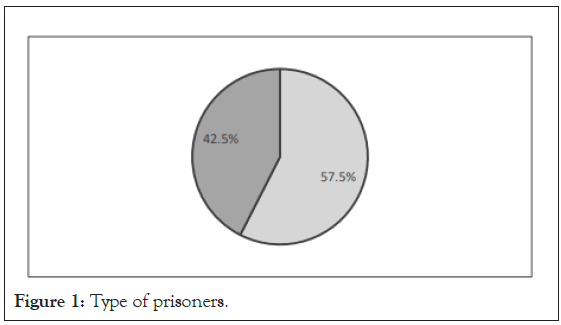
Figure 1: Type of prisoners.
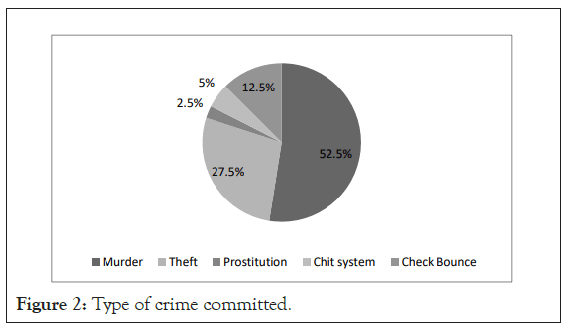
Figure 2: Type of crime committed.
The religious composition of the sample shows that majority of the respondents are Hindus with 82.5%, 15% of the participants are Muslims and 2.5% of the participants are Christians (Figure 3). 5% of the participants are Hindi speaking, 12.5% Tamil speaking, 55% Kannada speaking, 12.5% Telugu speaking, 12.5% Urdu speaking women and 2.5% Tulu speaking (Figure 4). 95% of respondents were literate and 5% of respondants were illiterate (Figure 5). 52.5% of the sample has been imprisoned for more than 3 months and less than a year and 47.5% of the sample have been imprisoned for more than a year (Figure 6). 17.5% of the respondents had never married, 2.5% are divorced and 80% are married (Figure 7).
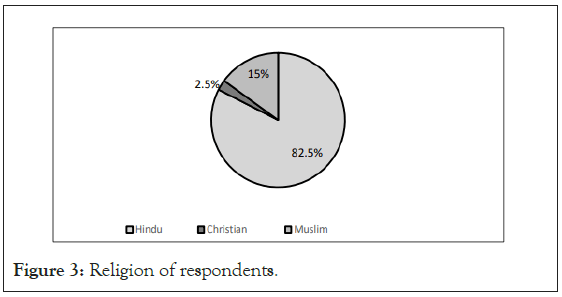
Figure 3: Religion of respondents.
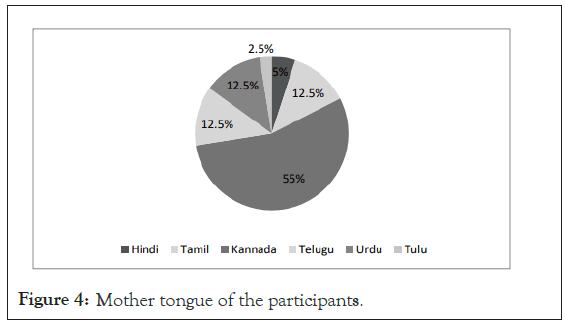
Figure 4: Mother tongue of the participants.
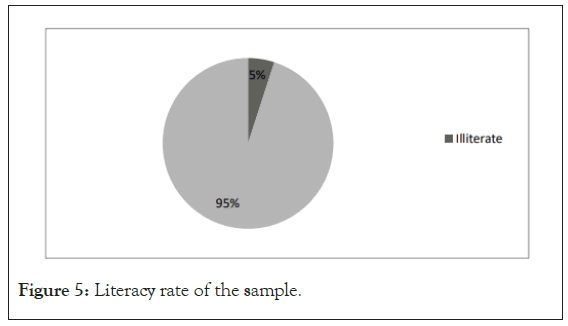
Figure 5: Literacy rate of the sample.
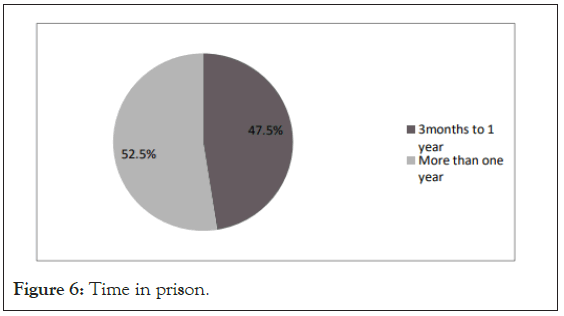
Figure 6: Time in prison.
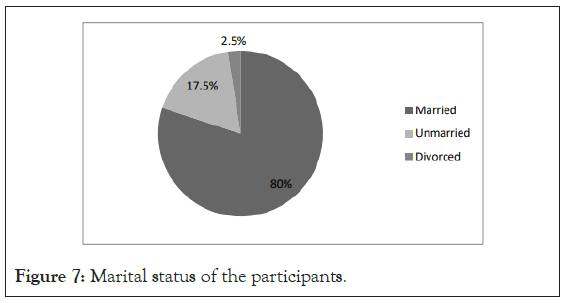
Figure 7: Marital status of the participants.
Table 1 show the normality of data where Resilience and Locus of Control are normally distributed. However, Agency thinking and Pathway thinking which are a part of Hope scale are not normally distributed hence non parametric tests were used for data analysis.
| Statistic | df | Sig. | |
|---|---|---|---|
| LOC | .964 | 40 | .24 |
| Resilience | .957 | 40 | .13 |
| Agency thinking |
.932 | 40 | .02 |
| Pathway thinking |
.930 | 40 | .02 |
Table 1: Test of normality for the study variables.
Resilience among women in prison
To find out the percentage of participants having low, average and high resilience, group norms were calculated, since the standardized norms were not available group norms were created using mean +/- 1 standard deviation. Norm for Resilience 2.94 -3.94. Twenty five percent have high resilience, Sixty five percent have average level of resilience and Ten percent have low resilience (Table 2).
| Group mean | Standard deviation | Range |
|---|---|---|
| 3.44 | 0.50 | 2.94-3.94 |
Table 2: Norms for brief resilience scale.
The hypothesis that there is no significant difference between under trials and convicts on resilience was tested using Mann Whitney U test. The obtained z value is not significant. Hence the null hypothesis is accepted (Table 3).
| Variable | Type of prisoner | Mean rank | Mann-Whitney U Test | z value | Sig |
|---|---|---|---|---|---|
| Resilience | UTC | 23.35 | 130 | 0.47 | 0.07 |
| CTC | 16.65 |
Note: *p> 0.05
Table 3: Comparison between under trials and convicts on resilience.
Hope among women in prison
To find out the percentage of participants having low, average and high Agency thinking and Pathway thinking, group norms were calculated, since the standardised norms were not available group norms were created using mean +/-1 standard deviation.
Norm for Pathway thinking=27.73–17.47. 10% of the participants are high on pathway thinking, Seventy two and half percent have scored average, Seventeen and half percent have scored low on pathway thinking.
Norm for Agency thinking=29.07–19.67. 10% have scored high in Agency thinking Seventy seven and half percent have scored average, twelve and half percent have scored low in Agency thinking (Tables 4 and 5).
| Sub variables | Group mean | Standard deviation | Range |
|---|---|---|---|
| Pathway thinking | 22.60 | 5.13 | 27.73 – 17.47 |
| Agency thinking | 24.37 | 4.70 | 29.07 – 19.67 |
Table 4: Norms for adult hope scale.
| Variable | Groups | Mean rank | Mann-Whitney U Test | z value | Sig |
|---|---|---|---|---|---|
| Agency thinking | Under-trails | 20.83 | 188 | 0.23 | 0.84 |
| Convicts | 20.06 | ||||
| Pathway thinking | Under-trails | 21.04 | 183 | 0.60 | 0.73 |
| Convicts | 19.76 |
Note: *p> 0.05
Table 5: Comparison between under trials and convicts groups on hope.
Table 5 shows the results of independent t-test between the convicts and under trials on hope. The hypothesis that there is no significant difference between under-trials and convicts on hope was tested using Mann Whitney U test. The obtained z value 0.23 and 0.60 is not significant. Hence the null hypothesis is accepted.
Locus of control among women in prison
Median score for locus of control is 12. Those scoring 12 and below have external locus of control and those scoring above 12 have internal locus of control. In the current study seventy seven and half percent of women have external locus of control and twenty two percent have internal locus of control (Table 6).
| Variable | Type of prisoner | Mean rank | Mann-Whitney U Test | z value | Sig |
|---|---|---|---|---|---|
| Locus of Control | UTC | 19.67 | 176.5 | 0.94 | 0.59 |
| CTC | 21.62 |
Note: *p>0.05
Table 6: Comparison between under-trials and convicts groups on locus of control.
Mann Whitney U-test was used to compare between the two groups on locus of control. As can be seen, the convicts group shows high locus of control with a mean rank of 21.62, but, it is not statistically significant (Z=0.94, p>.05). There is no significant difference between the convicts and undertrails on locus of control. Therefore, the null hypothesis has been retained.
Time in prison
Mann Whitney U-test was used to compare between the two groups on hope, resilience and locus of control. Table 7 shows the results of independent t-test between two groups of prisoners in jail from 3 months to 1 year and 1 year and more. As can be seen, the level of hope, resilience and locus of control between prisoners from 3 months to a year and prisoners from 1 year is not significant (Z=0.60, 0.23, 0.93, 0.64 respectively, p>.05). Therefore, the null hypothesis has been retained (Table 7).
The relationship between hope, resilience and locus of control
| Variable | Years in prison | Mean rank | Mann-Whitney U Test | z value | Sig |
|---|---|---|---|---|---|
| Agency thinking | 3 months to 1 year | 22.76 | 152 | -0.60 | 0.194 |
| 1 year and more | 18 | ||||
| Pathway thinking | 3 months to 1 year | 19.95 | 188 | -0.23 | 0.753 |
| 1 year and more | 21.11 | ||||
| Locus of control | 3 months to 1 year | 22.76 | 172.5 | -0.93 | 0.45 |
| 1 year and more | 18 | ||||
| Resilience | 3 months to 1 year | 19.67 | 176.5 | -0.64 | 0.52 |
| 1 year and more | 21.18 |
Note: *p>0.05
Table 7: Comparison between under-trials and convicts groups on locus of control.
To understand the relationship between locus of control, agency thinking, pathway thinking and hope, Spearman rank-order correlation coefficient (rs) was used which is a non-parametric test of correlation. As can be seen in Table 8, there is a no significant correlation between locus of control and resilience, locus of control and agency thinking as well as pathway thinking. (rs=0.02, 0.02, 0.01 respectively p<.0 1). The relationship between resilience and agency thinking, resilience and pathway thinking is also not significant (rs=0.09, 0.03 respectively). There is a significant correlation between agency thinking and pathway thinking as they are components of the same scale (rs=0.51, p<.01). Therefore, the null hypothesis has been accepted as there exists no significant relationship between locus of control, resilience, pathway thinking and agency thinking. The only significant relationship is between Agency and Pathway thinking which are components of the same scale (Table 8).
| Variables | Mean | SD | (1) | (2) | (3) | (4) |
|---|---|---|---|---|---|---|
| LOC (1) | 11.7 | 2.334 | 1.00 | 0.02 | 0.01 | 0.01 |
| Resilience (2) | 3.43 | 3.43 | 0.49598 | 1.00 | 0.09 | 0.03 |
| Agency thinking(3) | 22.6 | 5.13310 | 1.00 | 0.51** | ||
| Pathway thinking (4) |
24.37 | 4.70508 | 1.00 |
Note: **p>0.01
Table 8: Spearman correlation table for hope, resilience and locus of control.
Resilience among women in prison
Twenty five percent of the participants in this study have high resilience, which means they showcase resistance to illness, adaptation to stress, and functioning above the norm in spite of the stress. Carver, notes that individuals scoring high on resilience have a superior level of functioning in adverse situations. Prisoners who showcase high resilience adjust better; recover from illness, have an innate capacity to bounce back and are less susceptible to negative outcomes. Research also shows that resilience has a direct relationship with life events, which indicates that prisoners can bounce back to significant changes in their life [15,16].
Ten percent of the participants were low on resilience, which signifies that they are unable to adapt to the environment. They would use maladaptive way of coping and are highly susceptible to mental health disorders.
Hope among women in prison
Studies prove hopeful prisoners are more likely to flourish than prisoners who feel hopeless. Ten percent of the individuals who participated in the study have showcased high level of hope which indicates during difficult times prisoners are capable of identifying productive ways towards reaching their desired goals, cope and overcome stress, and report lower levels of daily stress. Ten percent of the participants scored low in hope which means they experience hopelessness, are prone to depression, unable to build healthy relationships in the prison and are more susceptible to comorbid disorders [17].
Research reports that individuals with high hope experience better overall physical, psychological, and social well-being and overall life meaning and sense of purpose [18]. In sum, the evidence suggests that the tenets of hopeful thinking can be leveraged to improve emotion regulation, well-being, and sense of purpose, relationship building, and achievement. This signifies that hope can exist even in an environment that is life-threatening and can perhaps lead to better outcomes.
Locus of control among women in prison
In the current study, seventy seven and a half percent of women have an external locus of control and twenty two and half percent have an internal locus of control which shows that seventy seven and a half percent of the participants believe in the concept of luck, which makes them take less of personal responsibility [19]. Participants with an internal locus of control have mastered their environment, exhibit a sense of personal mastery and are linked with better health outcomes, overall well-being and less stress [20].
Prisoners who conserve an internal locus of control adjust more efficiently to incarceration and release than compared to prisoners with an external locus of control. Prisoner’s showcasing internal locus of control are more capable of completing their term having fewer symptoms of depression, anxiety and anger issues. Showcasing internal locus of control is linked to better transition towards their community life [21].
Many studies described that incarcerated beings often demonstrated external locus of control which is consistent with the current findings of the study which means they involve in maladaptive behavior which are self-fulfilling in which they would not observe an association between their actions and the subsequent consequences [22]. An external locus of control has been found to be related to poor coping with stress and Selfdefeating personality styles [23].
Time in prison
The current study indicates that prisoners spending long years compared to prisoners with a short span of time showcase similar levels of hope, resilience, and type of locus of control. Brown in his article explains that attitudes to the legal establishment and aggression in recidivists and first-offenders. His findings prove a negligible difference between prisoners imprisoned for a week and those imprisoned for a year in the setting. Hence, personal characteristics, ways of adapting to the setting differ accordingly, making the time served in prison setting less significant compared to other confounding variables like social support, daily routine, basic facilities in the prison.
Bergh, Gatherer, Fraser and Moller note that many offenders enter prison with considerable foreknowledge of the environment. He stresses on prisoner’s adaptation strategies to the environment by getting adjusted to the culture, attempting to maximize choice, resting, accommodating and withdrawing, which make prison environment potentially less damaging.
Hence personal characteristics play a very significant role than the time of imprisonment.
Relationship between hope, resilience and locus of control
In the present study, there is no relationship between the variables Hope, Resilience and type of locus of control. This contradicts currently available studies which prove that sense of empowerment associated with increased perceptions of internal locus of control would be significantly associated with increased hope.
Increased hope is valuable because of hope’s associated benefits to other variables of wellbeing, such as resilience. This suggests that higher levels of hope affect resilience in individuals which is contradictory to the current study. Current findings are also contrary to the findings of Hooper, Marotta, and Lanthier, who found a significant relationship between the three variables hope, resilience and locus of control [24-33].
Most of the participants have external locus of control, moderate level of hope and resilience. There is no significant difference between convicts and under trials on all the variables of the study. There is no significant relationship between hope, resilience and locus of control. The present proves that short term and long term imprisonment does not affect prisoner’s level of hope, resilience and locus of control.
Sample size was a limitation for the study. The study does not consider other variables which affect the study like personality characteristics, prison environment and support systems. Information collected was limited to only one prison due to the availability and resources for the study which affects the generalization of the study.
Implications
Current study caters to the sensitive population that has received less importance due to the legal proceedings and the stigma attached to the population. Studies in the recent past have concentrated on variables such as criminality, sexual abuse, aggression and their mental health. However, studies on prisoners’ emotional well-being, their personality and psychological affect have received less attention. The current study stresses on prisoners’ hope, resilience and locus of Control which can be linked to recidivism, coping mechanisms, and their ability to adapt to the outside world after serving their punishment period. Since a large majority of the participants have external locus of control, and moderate level of hope and resilience, intervention can be planned to improve these aspects.
Gender can play a significant role and hence researchers can conduct studies comparing female and male prisoners. Studies can further focus on variables that affect the study such as social support, monetary benefits, prison setting, prison culture, wellbeing, etc. Researchers can explore if religion, education, social support, place of birth, family origin, social support, addiction have an impact on their criminal behaviour.
Citation: Jagadish SO (2021) Hope, Resilience and Locus of Control among Women in Prison. J Psychol Psychother. S2:003.
Received: 14-May-2021 Accepted: 28-May-2021 Published: 04-Jun-2021 , DOI: 10.35248/2161-0487.21.s2.e003
Copyright: © 2021 Jagadish SO. This is an open-access article distributed under the terms of the Creative Commons Attribution License, which permits unrestricted use, distribution, and reproduction in any medium, provided the original author and source are credited.